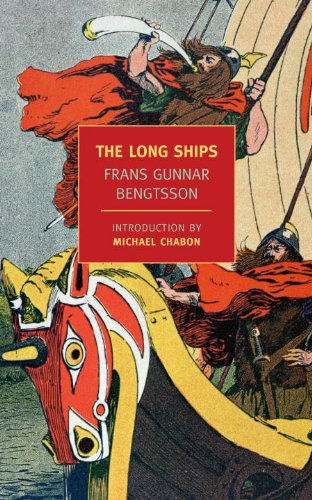The Long Ships, originally written in Swedish and translated into English in 1955, was reissued by New York Review Books in 2010. Michael Chabon gives it an enthusiastic introduction, marveling that he knows only three other people who have read the book. But this isn’t exactly a lost gem. The Long Ships has been a classic in Sweden for many generations, and it formed the basis of a 1964 movie starring Sidney Poitier.
The hero of The Long Ships—this is definitely a story with a Hero—is Red Orm, a Danish warrior who stumbles and pillages his way through Europe and Scandinavia in 1000 AD, rubbing elbows with the great kings of the Dark Ages and shedding blood in pivotal conquests. His misadventures at sea bring him to the palaces of Moorish Spain, the rocky monasteries of Ireland, and the nomadic tribes of the Russian steppe. Orm may not be as clever as Odysseus, but he’s luckier and more brutal in battle, and he travels more of the known world. Between sea voyages he dutifully raises a boisterous family on the edge of the Swedish forest.
Although it’s chiefly an adventure tale, with enough bloody swords and casual rape to satisfy a lusty 12-year-old, The Long Ships draws on extensive historical research and a rich literary tradition. Bengtsson, who wrote a PhD on Geoffrey Chaucer, studied many of the same sources that inspired J.R.R. Tolkien to write his contemporaneous The Lord of the Rings. Bengtsson sends Orm, for example, to the Battle of Maldon in 991, which Tolkien fictionalized in “The Homecoming of Beorhtnoth Beorhthelm’s Son.” With its glorification of Danish warriors and its credulity toward witches and trolls, The Long Ships echoes Beowulf. And it may be fair to surmise that Bengtsson relied on the same lost manuscript of a 10th century Arab-Viking encounter that inspired Michael Crichton to write Eaters of the Dead.
This legwork allows Bengtsson to craft his adventure tale with all the artistic authenticity it can handle. His language is deliberately archaic and feels instantly legendary—the kind of text you expect to be indexed by chapter and verse. It contains monologues, embedded folklore, and entire passages of crafty deliberation, which can be even more exciting than bloodshed.
They saw men climb ashore wearing garments barked with ice, among them a tall chieftain in a blue cloak and another, of equal stature, clothed in red. King Harald scanned them as closely as he could from where he stood, and said: “It looks like a Jomsviking or perhaps a Swedish ship, and it is boldly manned, for its crew approach the King of the Danes with no shield of peace upon their masthead. I know of but three men who would dare to come thus: Skoglar-Toste, Vagn Akesson, and Styrbjörn. Morover, they have brought their ship alongside without removing their dragon-head, though they know well that the trolls of the mainland do not love dragon-heads; and I know of but two men who do not care what the trolls think, and they are Vagn and Styrbjörn. But I see from the ship’s condition that its captain disdained to seek shelter from last night’s storm, and there is but one man who would refuse to bow to such a tempest. It is my guess, therefore, that this must be my son-in-law Styrbjörn.”
The stately, slow procession of language contrasts beautifully with the sudden turns of plot and the precarious cheapness of life in 1000 AD. Violence comes quickly, but our view of a bustling, exotic world, stretching from Córdoba to Kiev, unfolds magisterially. We learn about Orm’s world through his limited perspective—what he sees from the bow of his ship, what he hears as rumor—and the information feels late and unreliable, but somehow romantic, like gazing at a star whose light is a million years old.
It’s easy to see why Sweden loves this lively, readable epic. It flatters their national self-identity by offering an imagined history of the far North, with Irish jesters, dancing bears, strong ale, poetry, punitive beard-shaving, and ancient wild oxen. It valorizes berserker rage, plunder, and wife-theft as honorable deeds undertaken for the good of family and kingdom. Its only glaring fabrication is Orm’s true love for Ylva, the daughter of King Harald Bluetooth—an anachronism that makes our hero more endearing.
The Long Ships is a tribute to the moment in history when a barbaric society gives way to an ordered civilization. In Scandinavia Christianity did much of this work, and The Long Ships is highly ambivalent about Christianity. Priests are hypocritical, nattering twits who believe in love potions and the healing power of leeches. But they are also wise and loyal friends. Orm himself is a pragmatist; at sea he makes sacrifices to the Norse god Agir, Allah, and St. James, covering all the bases. But as he matures, he builds a church and oversees the baptism of his family and neighbors. Orm’s conversion signals the transition of Viking clans into modern Scandinavia.
After all of Red Orm’s voyages “there were no local incidents worth mentioning, apart from the usual murders at feasts and weddings, and a few men burned in their houses as the result of neighborly disputes.” Orm is both proud and sad to be hanging up his sword, and so is Bengtsson, and so are we.
- Brian Hurley



45 year tolkein reader heard long ships is compareable.cant wait 2 read.Found brief reading on google.GUess its time for books
[…] not like Michael Chabon is offering a critical exegesis. In his introduction to the other book—The Long Ships by Frans Gunnar Bengtsson—he reflects on how a dear aunt gave him the book once, and he’s loved […]
[…] got everyone talking about The Flame Alphabet, and our beloved readers came through with some great nominations, none of those book reviews actually won. I know, I know. You’re aghast. Well, the competition […]
[…] Read all of the reasons in the Fiction Advocate review of “The Long Ships.” Advertisement GA_googleAddAttr("AdOpt", "1"); GA_googleAddAttr("Origin", "other"); GA_googleAddAttr("theme_bg", "ffffff"); GA_googleAddAttr("theme_text", "333333"); GA_googleAddAttr("theme_link", "772124"); GA_googleAddAttr("theme_border", "eeeeee"); GA_googleAddAttr("theme_url", "58181b"); GA_googleAddAttr("LangId", "1"); GA_googleAddAttr("Autotag", "books"); GA_googleAddAttr("Autotag", "football"); GA_googleAddAttr("Tag", "other-peoples-stuff"); GA_googleAddAttr("Tag", "brian-hurley"); GA_googleAddAttr("Tag", "fiction-advocate"); GA_googleAddAttr("Tag", "gunnar-bengtsson"); GA_googleAddAttr("Tag", "the-long-ships"); GA_googleAddAttr("Tag", "vikings"); GA_googleFillSlot("wpcom_sharethrough"); Share this:Like this:LikeBe the first to like this post. from → Other People's Stuff ← The Infinite Jest Liveblog: Cult Classics No comments yet […]